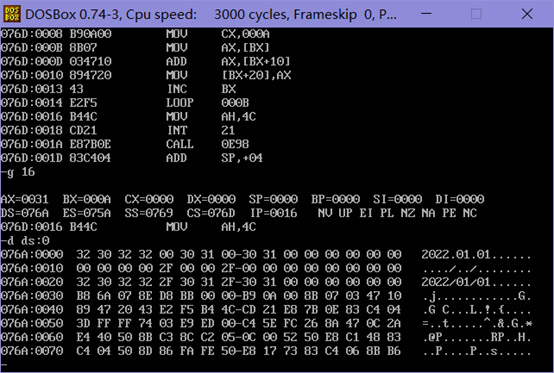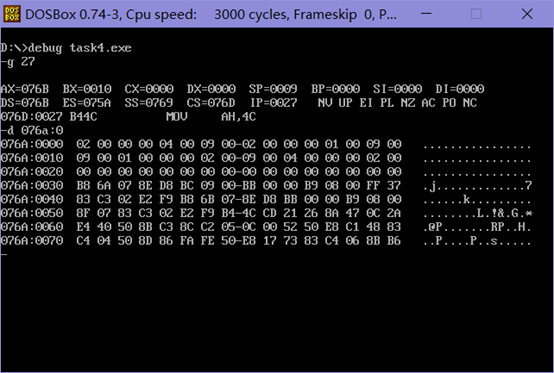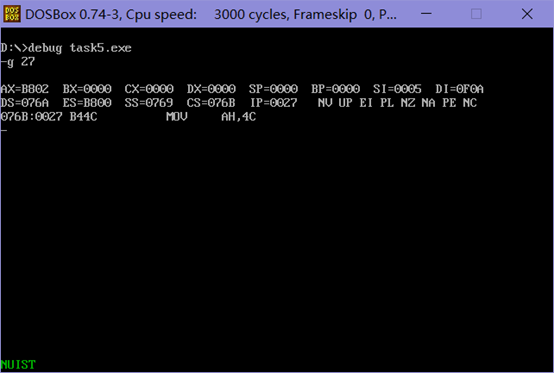1. Experimental Purpose

Register DS=076A; SS=076B; CS=076C;
Code's address segment is X, Data's address segment is X-32; The address segment of the stack is X-16
Tasks 1-2

Register DS=076A; SS=076B; CS=076C;
Code's address segment is X, Data's address segment is X-12; The address segment of the stack is X-8
Tasks 1-3

Register DS=076A; SS=076C; CS=076E;
Code's address segment is X, Data's address segment is X-40; The address segment of the stack is X-20
Tasks 1-4

Register DS=076C; SS=076E; CS=076A;
Code's address segment is X, Data's address segment is X+20; The address segment of the stack is X+40
Tasks 1-5
1:16*(N/16 rounded up)
2:task1-4 works because start indicates the starting position of the code snippet and executes automatically from the beginning of the program after the end is removed. Only 1-4 instructions start at the beginning of the program, while others start with data segments and are incorrectly recognized as instructions and cannot be executed.
Task 2
Write an assembly source program to fill hexadecimal data 03 04 in succession to memory unit b800:0f00 ~ b800:0f9f for 160 bytes
1 assume cs:code 2 3 code segment 4 5 start: 6 mov ax, 0b800h 7 mov ds, ax 8 mov bx, 0f00h 9 10 mov cx, 50h 11 mov ax, 0403h 12 s: mov ds:[bx], ax 13 add bx, 2 14 loop s 15 16 mov ah, 4ch 17 int 21h 18 code ends 19 end start

3. Experimental Task 3
1 assume cs:code 2 data1 segment 3 db 50, 48, 50, 50, 0, 48, 49, 0, 48, 49 ; ten numbers 4 data1 ends 5 6 data2 segment 7 db 0, 0, 0, 0, 47, 0, 0, 47, 0, 0 ; ten numbers 8 data2 ends 9 10 data3 segment 11 db 16 dup(0) 12 data3 ends 13 14 code segment 15 start: 16 mov ax, data1 17 mov ds, ax 18 mov bx, 0 19 mov cx, 0ah 20 s: mov ax, ds:[bx] 21 add ax, ds:[bx+10h] 22 mov ds:[bx+20h], ax 23 inc bx 24 loop s 25 26 mov ah, 4ch 27 int 21h 28 code ends 29 end start

4. Experimental Task 4
1 assume cs:code, ss:stack 2 3 data1 segment 4 dw 2, 0, 4, 9, 2, 0, 1, 9 5 data1 ends 6 7 data2 segment 8 dw 8 dup(0) 9 data2 ends 10 11 stack segment 12 dw 8 dup(0) 13 stack ends 14 15 code segment 16 start: 17 mov ax, data1 18 mov ds, ax 19 mov sp, 9 20 mov bx, 0 21 mov cx, 8 22 s1: push ds:[bx] 23 add bx, 2 24 loop s1 25 26 mov ax, data2 27 mov ds, ax 28 mov bx, 0 29 mov cx, 8 30 s2: pop ds:[bx] 31 add bx, 2 32 loop s2 33 mov ah, 4ch 34 int 21h 35 code ends 36 end start

Experiment Task 5
1 assume cs:code, ds:data 2 data segment 3 db 'Nuist' 4 db 5 dup(2) 5 data ends 6 7 code segment 8 start: 9 mov ax, data 10 mov ds, ax 11 12 mov ax, 0b800H 13 mov es, ax 14 15 mov cx, 5 16 mov si, 0 17 mov di, 0f00h 18 s: mov al, [si] 19 and al, 0dfh 20 mov es:[di], al 21 mov al, [5+si] 22 mov es:[di+1], al 23 inc si 24 add di, 2 25 loop s 26 27 mov ah, 4ch 28 int 21h 29 code ends 30 end start

Question 3:line19 Role:
0dfh=0000 1101 1111, phase operation changes lowercase ASCII value from 32 to uppercase
Question 4: Modify the value of 5 byte units in line4, reassemble, link, run, and observe the result.
Run result: db 5 dup(2)

Experiment Task 6
1 assume cs:code, ds:data 2 3 data segment 4 db 'Pink Floyd ' 5 db 'JOAN Baez ' 6 db 'NEIL Young ' 7 db 'Joan Lennon ' 8 data ends 9 10 code segment 11 start: 12 mov ax, data 13 mov ds, ax 14 15 mov ax, data 16 mov es, ax 17 18 mov bx, 0 19 mov cx, 4 20 s1: mov si, cx 21 mov cx, 4 22 s2: mov al, es:[bx] 23 or al, 20h 24 mov es:[bx], al 25 inc bx 26 loop s2 27 28 mov cx, si 29 mov bx, 0 30 31 mov ax, es 32 inc ax 33 mov es, ax 34 35 loop s1 36 mov ah, 4ch 37 int 21h 38 code ends 39 end start

1 assume cs:code, ds:data, es:table
2
3 data segment
4 db '1975', '1976', '1977', '1978', '1979'
5 dd 16, 22, 382, 1356, 2390
6 dw 3, 7, 9, 13, 28
7 data ends
8
9 table segment
10 db 5 dup( 16 dup(' ') )
11 table ends
12
13 code segment
14 start:
15 mov ax, data
16 mov ds, ax
17 mov ax, table
18 mov es, ax
19
20 mov bx, 0
21 mov si, 0
22 mov di, 0
23 mov cx, 5
24 year:
25 mov dx, cx
26 mov cx, 4
27 yearnum:
28 mov al, byte ptr ds:[di]
29 mov byte ptr es:[bx][si], al
30 inc si
31 inc di
32 loop yearnum
33
34 mov cx, dx
35 add bx, 10h
36 mov si, 0
37 loop year
38
39 mov bx, 0
40 mov si, 5
41 mov cx, 5
42 income:
43 mov ax, word ptr ds:[di]
44 mov word ptr es:[bx][si], ax
45 add si, 2
46 add di, 2
47 mov ax, word ptr ds:[di]
48 mov word ptr es:[bx][si], ax
49 add si, 2
50 add di, 2
51
52 add bx, 10h
53 mov si, 5
54
55 loop income
56
57 mov bx, 0
58 mov si, 0Ah
59 mov cx, 5
60 employee:
61 mov ax, word ptr ds:[di]
62 mov word ptr es:[bx][si], ax
63 add si, 2
64 add di, 2
65
66 add bx, 10h
67 mov si, 0Ah
68
69 loop employee
70
71 mov bx, 0
72 mov si, 5
73 mov cx, 5
74 average:
75 mov ax, word ptr es:[bx][si]
76 add si, 2
77 mov dx, word ptr es:[bx][si]
78 add si, 3
79 div word ptr es:[bx][si]
80 add si, 3
81 mov word ptr es:[bx][si], ax
82
83 add bx, 10h
84 mov si, 5
85 loop average
86
87
88 mov ah, 4ch
89 int 21h
90 code ends
91 end start




Result:
Prior to implementation:

40~80 as spaces
After implementation:

The top four columns of 40-80 are year, 6-9 are income, 11,12 are employees, and 14,15 are average income.
Result table:
| 1-4 years | 6~9 Income | 11,12 Employees | 14,15 Average Income | |
| 40 | 1975 | 0010h | 03 | 05 |
| 50 | 1976 | 0016h | 07 | 03 |
| 60 | 1977 | 017eh | 09 | 2a |
| 70 | 1978 | 054ch | 0d | 68 |
| 80 | 1979 | 0956h | 1c | 55 |